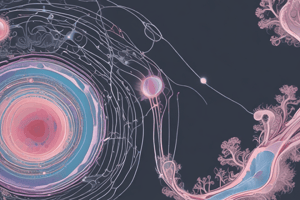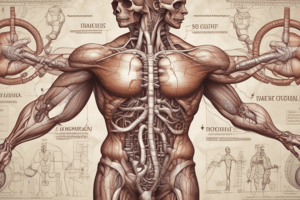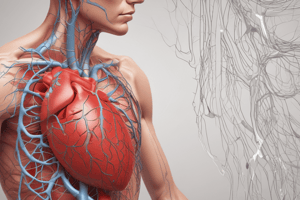Podcast
Questions and Answers
How did the US influence post-war reconstruction in relation to Europe?
How did the US influence post-war reconstruction in relation to Europe?
- By forming trade alliances with Asian countries
- By initiating military occupations in several countries
- By investing heavily in reconstruction efforts (correct)
- By imposing tariffs on European goods
What was a significant consequence of European states re-evaluating their colonial empires after WWII?
What was a significant consequence of European states re-evaluating their colonial empires after WWII?
- They adopted economic policies that favored further colonization
- They faced severe political violence and unrest (correct)
- They sought to replicate the US model of expansion
- They rapidly expanded their territories in Africa
Which of the following statements accurately reflects the impact of international organizations like the IMF post-WWII?
Which of the following statements accurately reflects the impact of international organizations like the IMF post-WWII?
- They focused solely on agricultural investments
- They limited membership to countries supporting free trade (correct)
- They promoted equal trade access for all member countries
- They exclusively funded military endeavors globally
Which regions primarily struggled with economic development in the post-war period?
Which regions primarily struggled with economic development in the post-war period?
What role did the US play in the decolonization process after WWII?
What role did the US play in the decolonization process after WWII?
What characterized the United States' role in international finance after World War II?
What characterized the United States' role in international finance after World War II?
Which countries are classified as First World under the three-world structure?
Which countries are classified as First World under the three-world structure?
What emerged in Europe after World War II that significantly changed their economic policies?
What emerged in Europe after World War II that significantly changed their economic policies?
What was the significance of the Balance of Terror during the Cold War?
What was the significance of the Balance of Terror during the Cold War?
According to post-Cold War analysis, what significant shift occurred regarding global ideologies?
According to post-Cold War analysis, what significant shift occurred regarding global ideologies?
What has contributed to the decline of the US as a superpower in the 21st century?
What has contributed to the decline of the US as a superpower in the 21st century?
What three key features characterized the new global system after the Cold War?
What three key features characterized the new global system after the Cold War?
What was the role of the US firms in the global economy post-World War II?
What was the role of the US firms in the global economy post-World War II?
What was a significant outcome of the decolonization process after WWII?
What was a significant outcome of the decolonization process after WWII?
How did the post-WWII economic climate influence state policies?
How did the post-WWII economic climate influence state policies?
What major shift occurred in economic structures towards the end of the 20th century?
What major shift occurred in economic structures towards the end of the 20th century?
What role did multinational corporations play in the late 20th century?
What role did multinational corporations play in the late 20th century?
What characterized the relationship of newly independent states with their former colonial powers?
What characterized the relationship of newly independent states with their former colonial powers?
Which movement emerged in response to the pressures of the US and USSR during the Cold War?
Which movement emerged in response to the pressures of the US and USSR during the Cold War?
What impact did the rise of sophisticated technologies in the 21st century have on production?
What impact did the rise of sophisticated technologies in the 21st century have on production?
What challenge regarding trade emerged in the 21st century due to globalization?
What challenge regarding trade emerged in the 21st century due to globalization?
Flashcards
Post-War Reconstruction
Post-War Reconstruction
The process of rebuilding and restoring economic and social structures after a war, often with support from other countries.
International Organizations
International Organizations
Groups of nations working together for common goals, like promoting trade or solving global problems.
Regional Economic Institutions
Regional Economic Institutions
Organizations formed by countries in a specific region to enhance economic relations (e.g., EU, NATO).
Decolonization
Decolonization
Signup and view all the flashcards
Anti-colonial Movements
Anti-colonial Movements
Signup and view all the flashcards
Welfare state
Welfare state
Signup and view all the flashcards
Three-World Structure
Three-World Structure
Signup and view all the flashcards
Cold War
Cold War
Signup and view all the flashcards
Mutually Assured Destruction
Mutually Assured Destruction
Signup and view all the flashcards
US Economic Expansion
US Economic Expansion
Signup and view all the flashcards
Globalization
Globalization
Signup and view all the flashcards
Competition State
Competition State
Signup and view all the flashcards
IMF
IMF
Signup and view all the flashcards
Hyperpower
Hyperpower
Signup and view all the flashcards
Deglobalization
Deglobalization
Signup and view all the flashcards
State Transformation
State Transformation
Signup and view all the flashcards
New Global Threats
New Global Threats
Signup and view all the flashcards
First World
First World
Signup and view all the flashcards
Second World
Second World
Signup and view all the flashcards
Third World
Third World
Signup and view all the flashcards
Study Notes
Post-War Reconstruction and Global Order
- Post-war reconstruction was aided by US investment.
- International organizations were established to promote international trade, but the IMF and similar institutions prioritized free trade, limiting membership to countries committed to it.
- Regional economic institutions emerged, like the EU and NATO.
- The EU has grown into an economic force balancing US dominance.
Decolonization
- European empires rapidly dissolved after World War II.
- European states realized the difficulty of governing foreign territories, and violent anti-colonial movements forced them to reconsider their empires.
- The French were more aggressive in retaining their empire than the British, leading to bloody conflicts in Algeria and Vietnam.
- The US supported decolonization, granting independence to the Philippines in 1946 and urging other European nations to release their colonies. It opposed the British, Israeli, and French invasion of Egypt during the Suez Crisis.
- Many post-colonial states faced economic development challenges in the 20th century, with only a few becoming industrialized (Ireland, South Korea, Taiwan). Latin America and Africa witnessed weaker economic growth and remained heavily reliant on primary sectors like agriculture and raw materials.
US Economic Expansion
- The US economy experienced significant growth after World War II.
- By the war's end, the US accounted for half of global output.
- It dominated international finance, extending massive loans to Europe during the war.
Emergence of the Welfare State
- European countries established welfare states after the war.
The Three-World Structure
- The emergence of the three-world structure:
- First World: Western Europe, US, Canada, Australia, New Zealand, Japan
- Second World: Communist states of Eastern Europe and Soviet Russia
- Third World: Developing countries
The Cold War
- Continued conflict with Russia evident from the war's final years.
- The concept of "Mutually Assured Destruction" emerged with the development of nuclear weapons by Russia.
Post-Cold War Developments
- The post-Cold War period saw the rise of new global threats:
- Conflicts in the former Yugoslavia and Rwanda
- The threat of fundamentalist Islam
- The emergence of new economic powers like China.
- The idea of Western ideology triumphing (capitalism over communism) was prevalent for a time.
- Francis Fukuyama (1992) argued that there would be no new societal models, and everyone would adopt a liberal democratic model.
- As the 21st century approached, some analysts began to refer to the US as a "hyperpower" due to its military might, economic dominance, and cultural influence.
- However, the 21st century witnessed a decline in US power.
- Key features of the new global order included liberalism, legalism, and materialism (Ravenill, 2020).
State Transformation
- The post-World War II period was characterized by an active state role in safeguarding citizens from market fluctuations through extensive welfare programs.
- A shift from the welfare state to the competition state occurred near the end of the 20th century.
- This shift involved a move away from supporting failing industries and sectors towards a more globally competitive economy.
- Welfare-to-work initiatives replaced universal social policies of earlier generations.
- Different economic responses to the Great Recession and the COVID-19 pandemic emerged.
International Organizations and Globalization
- The second half of the 20th century saw the growth of international organizations:
- United Nations (UN)
- Economic organizations
- Corporate and civic associations
- Multinational corporations dominated trade innovation in the late 20th century.
- In the 21st century, production shifted from assembly lines to sophisticated technologies and computer-based production, leading to customized products and globalized production processes.
- New products emerged and disappeared rapidly, sparking questions about sustainability.
- This led to outsourcing and specialization in trade, contributing to the rise and challenges of globalization and deglobalization.
- The emergence of artificial intelligence presents additional challenges.
Patterns in Economic Activity
- Across centuries, recurring patterns in economic activity can be recognized.
- The global economy of the early 21st century is a product of developments from previous centuries.
Studying That Suits You
Use AI to generate personalized quizzes and flashcards to suit your learning preferences.





